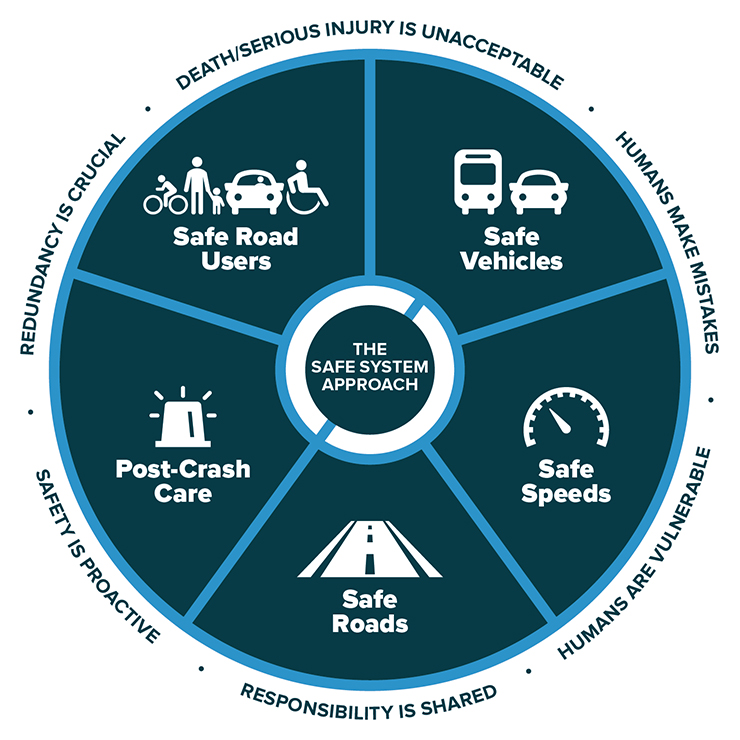Caltrans, Partners Push More Inclusive Safety Plan
New Principles Affirm State’s Commitment to Equity, Holistic Solutions

Caltrans and its transportation safety partners are going the extra mile to strengthen California’s guiding plan on how to improve safety for travelers and communities.
Convinced that a broader strategy was needed to reduce fatalities and serious injuries on state and local roadways, the multi-agency group that developed the California Strategic Highway Safety Plan (SHSP) agreed on a new set of guiding principles for inclusion in the 2020-24 SHSP to further improve safety.
The SHSP was released earlier this year by the consortium of agencies under the California State Transportation Agency (CalSTA), which includes Caltrans, and federal transportation representatives and stakeholders. The plan is typically updated every five years, and this year’s version was seen as a critically important joint effort to combat the sharp rise in deaths and serious injuries that have occurred along California roadways since 2000.
Meeting over the summer, state transportation leaders decided that bringing down the number of deaths and serious injuries on public roadways required a bolder and more focused approach than outlined in the recently adopted SHSP. The group agreed to incorporate the following guiding principles into the plan, to make the SHSP more reflective of new thought and safety strategies:
Integrate equity — Caltrans is seeking to address institutional and systemic racial bias from previous transportation decisions that split communities or restricted choices for vulnerable populations.
To remedy injustices, Caltrans proposes to integrate equity when implementing strategies, proposed actions, and future development criteria and evaluation; expand data sets to evaluate for inherent biases; increase participation from persons or agencies that represent traditionally underserved populations; ensure outreach activities include or target those populations; and develop a robust working definition of equity for the SHSP.

Implement “Safe System” approach — This holistic strategy holds that people using a transportation system will make mistakes, and roads should be planned and built to be forgiving of errors in judgment. Safe System calls for shared responsibility to minimize or eliminate deaths and serious injuries on the roadway by making safer vehicles, reducing speeds, designing safer roads, and improving post-crash care and analysis.
Caltrans has embraced the zero deaths and serious injuries goal embodied with the Safe System approach.
Double down on what works — Caltrans should continue to focus on implementing proven safety countermeasures that address collision “hotspots” as well as make broader, systemic improvements to parts of the transportation system. Some of the specific countermeasures that Caltrans will make a concerted effort to widely implement are published in the Federal Highway Administration’s Proven Safety Countermeasures.
Caltrans manages the Highway Safety Improvement Program (HSIP), which dispenses federal funds for infrastructure projects in California that employ these countermeasures with a record of reducing fatalities and serious injuries on public roads. In fiscal year 2018-19, a total of $639.6 million was committed to fund 221 state and local safety projects, $182 million provided by federal HSIP.
Accelerate advanced technology — As it always has, Caltrans encourages and adopts technological innovations that promote roadway safety. To expand that process, the Department plans new partnerships with technology providers, safety/health groups, manufacturers and government partners to identify and prioritize safety applications and opportunities, evaluate safety benefits, and increase consumer interest and education.
Next Steps
The SHSP Executive Leadership Committee that met in July also decided to retain a list of safety “challenge areas” from the 2014-2019 SHSP. These 16 areas were based on factors that contribute to collisions that cause fatalities and serious injuries.
The Committee agreed to prioritize six of those challenge areas: impaired driving, aggressive driving/speed management, lane departures, intersections, and pedestrians/bicyclists. Because of its roadway operations and maintenance expertise and engineering acumen, Caltrans is expected to take the lead on addressing several of these safety priorities.
The SHSP Executive Leadership Committee has been meeting bi-monthly and is scheduled to convene again in March 2021 to implement the new principles and ensure that the SHSP and the corresponding implementation plan integrate the new guiding principles and help improve safety throughout California.
Sources: Caltrans Division of Safety Programs; 2020–2024 Strategic Highway Safety Plan.

